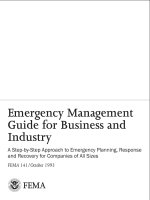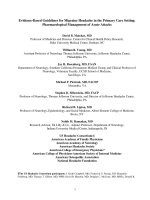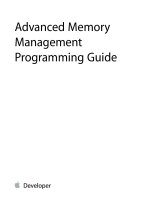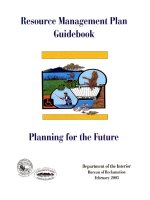competency management apractitioners guide
Bạn đang xem bản rút gọn của tài liệu. Xem và tải ngay bản đầy đủ của tài liệu tại đây (892.6 KB, 127 trang )
Competency
Management
- A Practitioner's Guide
R. Palan Ph.D.
In cooperation with
Rosetta Solutions, Inc.
www.rosettasolutions.com
Produced by
RosettaMachine
www.rosettamachine.com
Competency Management - A Practitioner’s Guide
ii
Copyright © R. Palaniappan 2003
All rights reserved. No part of this publication may be reproduced, stored
in a retrieval system, or transmitted, in any form or by any means,
electronic, mechanical, photocopying, recording or otherwise, without the
prior written permission of the publisher.
Published by:
Specialist Management Resources Sdn Bhd (Co. no. 385604-V) 14-4
Jalan Bangsar Utama 1,
Bangsar Utama, 59000 Kuala Lumpur, Malaysia
Tel: 603-2282 8313 Fax: 603-2282 9313
Email:
Website: www.smrhrd.com
Perpustakaan Negara Malaysia Cataloguing - in - Publication Data:
R. Palaniappan (R. Palan Ph.D.)
Competency Management - A Practitioner's Guide
Print Edition ISBN No: 983-41398-0-2
Ebook editions produced by
Rosetta Solutions, Inc.
www.rosettasolutions.com
Ebook conversion and distribution powered by
www.RosettaMachine.com
Adobe PDF Edition ISBN: 983-42586-0-7
Microsoft LIT Edition ISBN: 983-42586-1-5
Mobipocket PRC Edition ISBN: 983-42586-3-1
Palm PDB Edition ISBN: 983-42586-2-3
Editorial team
Consultant: Dr. Nat
Language: Renu Joseph
Layout / Graphics: Agnes Peter
Competency Management - A Practitioner’s Guide
iii
Printed in Malaysia by:
Percetakan Suma
1 Batu 6, Gombak,
53100, Kuala Lumpur.
First: Published:July 2003
Reprint: September 2003
Competency Management - A Practitioner’s Guide
iv
Dedicated to
Dr Nat, a friend and colleague
for
his friendship, encouragement,
and support for
my writing
Competency Management - A Practitioner’s Guide
v
Contents
Preface
Section One: Understanding Competencies
Chapter 1 - Introduction
1. What are competencies?
2. Two terms
3. Confusion
4. Clarification
4.1 Competency
4.2 Competence
4.3 Two more terms
4.4 The SMR perspective
5.Why competencies?
5.1 Organisational issues
5.2 Employee issues
5.3 The linkage between competency and performance
6. Competency management
7. The SMR experience
Chapter 2 - Competency Models
1. What are models?
1.1. Facts, inferences, and constructs
1.2 Examples of models
2. Competency models and four questions
2.1 Need for a competency model
2.2 Strategies for model building
2.3 Available financial and human resources
2.4 Significance of stakeholders
2.5 Developing a model
Competency Management - A Practitioner’s Guide
vi
3. The Boyatzis model for effective performance
3.1 Competencies and performance
3.2 Causal and associational links
3.3 Competency clusters
4. Competency model - the SMR view
4.1 The Roman Pavilion competency framework
Section Two: Competency Implementation Approach
Chapter 3 - Competency Implementation
1. Introduction
2. Getting management buy in
2.1 Get explicit support
2.2 Project scope document
2.3 Discussion on action plan
2.4 Initiate pilots
3. Implementing the project plan
3.1 Project team
3.2 Establishing business rules
4. Competency profiling
4.1 Creating the competency dictionary
4.2 Competency mapping
4.3 Competency matrix
4.4 Assessment
4.5 Data management
4.6 Sustaining competency management
Chapter 4 - SMR Experience
1. SMR approach
1.1 Position
1.2 Person
1.3 Programmes
1.4 Assessment
1.5 Gap analysis
1.6 Evaluation
Competency Management - A Practitioner’s Guide
vii
2. SMR's Six steps in implementing competency projects
2.1 Commencement
2.2 Development
2.3 Pilot
2.4 Roll out
2.5 Linking to applications
2.6 Conclusion
3. Learning from field experiences
3.1 Types of users
3. 2 Factors affecting success or failure of competency project
Section Three
1. Glossary
2. Frequently asked questions
Bibliography
About SMR
Competency Management - A Practitioner’s Guide
1
Preface
There is a strong business case for competencies at work as they do lead to
significant human resource development that provide organisations with a
competitive edge. The case for competency management has grown
strongly since David McClelland wrote his article in 1973 and the
Management Charter Initiative (MCI) was launched in the UK, in the
eighties. Though we are aware that competencies by themselves are
insufficient for performance, there is ample evidence that competencies
form the bedrock for effective and superior performance. This is the
reason why organisations, both in the private and public sector, continue
to emphasise on them.
This book is a reflection of our experiences in the field of Competency
Management and Implementation. It does not aim to be an academic
treatise. The purpose of this book is to provide those attempting to
implement competencies in their organisations with a clear understanding
of competency management. The field experiences documented by our
project managers have been summarised for the practitioner.
There are three sections in the book. Section One (Chapters 1 and 2)
attempts to provide a clarification of the concept of competency while
Section Two (Chapters 3 and 4) details a competency implementation
approach, reinforced with the SMR experience. The last section includes a
glossary of terms and frequently asked questions.
The aim of Chapter One is to sieve through the many terms currently
being used in the competency field to clear much of the confusion.
Chapter Two provides information in a practical way to develop
competency models. The contributions of Richard Boyatzis, Lyle Spencer
and Signe Spencer, David McClelland, the MCI and SMR are elaborated
in an easy to understand manner. Chapter Three details the processes
involved in implementing competencies in a practical and cost effective
way. SMR's experience is detailed in the last chapter. The intention is to
guide the practitioner with success factors to follow and pitfalls to avoid.
Competency management can only be successful if the purpose of the
competency initiative is clearly established. When it is integrated with
Competency Management - A Practitioner’s Guide
2
applications that are linked with the organisational aspirations, line
managers see it as an enterprise initiative rather than an HR initiative.
When this happens, line managers support the project and organisations
achieve their development goals and the expected return on investments.
Two factors for success that we would like to highlight are the presence of
a project champion within the organisation and the pursuit of competency
as a long term initiative rather than a short term one. Both of these factors
are prerequisites for successful project management.
The success of a competency initiative can be justified by four factors:
x a performance improvement initiative,
x a talent acquisition exercise,
x an effective training and development programme that is just-in-
time and needs based, and
x the ability of the organisation to deploy human resources in an
effective manner resulting with the best person-position match not
just for the present but also for the future.
This book is the result of a collective effort of several of my colleagues. I
must thank all of them for their support. Dr. Nat, Murali, Renu, and Ed
Jackson require special mention. Dr. Nat, as usual, brought in a level of
conceptual clarity. Murali and the HRDPower team provided substantial
input by sharing their field and development experiences. They have been
successful in enabling rapid competency implementation with the
development of a very intuitive software, HRDPower. Renu struggled to
make sense of my disjointed thoughts to make the book readable. Her
attention to detail while editing the book helped me a great deal. Ed
Jackson, one of our shareholders and an outstanding project management
specialist continues to give us constructive advice both on the
development and consulting fronts. Many of his contributions on project
management are included in this book. Agnes and the printers rushed to
complete the design and the printing on time.
All our project managers deserve mention just as our customers who
provided us with the field experiences. The project managers followed the
game plan and documented the knowledge carefully. Our customers
provided us with tremendous learning experiences. Takamatsu and Silva
Competency Management - A Practitioner’s Guide
3
of Matsushita Air-conditioning, Donna Webster of Pan Pacific group of
hotels, Annette and Daniel at National Drilling, Seri and team at Malaysia
Shipyard Engineering, Datin Latiffah of the University Malaya Medical
centre, Raja Harris at Tenaga Generation, and Feldatun and team at
Tenaga Engineering. All the customers using our software — HRDPower
— around the world provided us with valuable feedback which resulted in
significant learning for us to fine tune our approach towards implementing
competency management.
I am grateful to my colleague and the Managing Director of SMR, Karen,
and her team for understanding my passion and supporting me in my
efforts to share our learning with the world. Last but not the least, I thank
my wife Kamu and sons Maha and Subbu who continue to tolerate my
disappearance and reluctantly accept my choice to write or consult instead
of being with them, on too many evenings and weekends. It reflects my
state of incompetence when it comes to work-life balance. .Of course, it
leaves room for improvement.
R. Palan
Kuala Lumpur, Malaysia
16 July 2003
Competency Management - A Practitioner’s Guide
4
Section One:
Understanding Competencies
Competency Management - A Practitioner’s Guide
5
CHAPTER 1
This chapter introduces the term competency. The discussion will cover
the following aspects.
x The meaning of the term 'competency.'
x The confusion between the terms 'competence' and 'competency.'
x SMR's stand on the use of these terms.
x Levels of competency.
x Types of competency: behavioural, functional, core, and role
competencies.
x Relevance of competency framework to organisations and
individuals.
x Linkage between competency and performance.
x The various approaches in competency management.
x The SMR experience.
Introduction
1. What are competencies?
The terms 'competencies,' 'competence,' and 'competent' refer to a state or
quality of being able and fit. The English dictionary describes the word
'competence' as the state of being suitable, sufficient, or fit. The workplace
definition of 'competency' refers to a person's fitness with reference to his
or her job. In the work context, however, competence has two variations
that differ in their meaning, depending on organisational frames of
reference.
2. Two terms
The two terms arise from different streams of thought on the concept of
fitness at work. They are:
Competency Management - A Practitioner’s Guide
6
1. 'Competency' which is a description of behaviour, and
2. 'Competence' which is a description of work tasks or job
outputs.
Despite the generally accepted distinction in meaning as given above, the
terms are still interchangeably used causing them to mean different things
to different people. There are also many who wonder if there is any
difference between the two terms.
3. Confusion
People using these terms shape their meaning to fit their own convenience.
Ronald Zemke's comments on these terms in 1982 remain valid even
today:
'Competency, competencies, competency models and competency-
based training are Humpty Dumpty words meaning only what the
definer wants them to mean. The problem comes not from malice,
stupidity, or marketing avarice, but instead from some basic
procedural and philosophical differences among those racing to
define and develop the concept and to set the model for the way
the rest of us will use competencies in our day-to-day effort.'
4. Clarification
Let us now review the terms as they are commonly used in practice today.
4.1 Competency
Competency refers to underlying behavioural characteristics that describe
motives, traits, self-concept, values, knowledge or skills that a superior
performer brings to the workplace.
According to this definition, competencies are made up of different types
of characteristics, which drive behaviour. These underlying characteristics
are evidenced in the way an individual behaves at the workplace.
Competencies are about what people are and can do, not what they do.
These competencies are observed in people who may be classified as
effective or superior performers. Superior performance refers to
Competency Management - A Practitioner’s Guide
7
performance that is above average. This is usually attributed to the top ten
percent of employees. For example, a salesperson with higher
achievement orientation sets challenging goals and achieves them, this
results in gains for the sales person and the organisation. To take another
instance, an interpersonal competency will be demonstrated in how
effectively a person gets along with other members of the team at the
workplace.
The purpose of this approach was to use the characteristics of superior
performers as templates for employee selection and development. This
builds the business case for using competencies because better hiring and
deployment decisions are possible when we know what characteristics
lead to superior performance.
The concept of competencies originated from David McClelland's
groundbreaking article, Testing for Competence Rather than Intelligence.
The article launched the competency movement in industrial psychology.
He concluded, on the basis of review of studies that traditional academic
aptitude and knowledge content tests, as well as school grades and
credentials:
1. Did not predict success either in job/life and
2. Were generally biased against the lower socio-economic
sections of society.
This led McClelland to ask what predicted success, if not intelligence? He
started to look for research methods that would identify competency
variables, which would predict job performance and were not influenced
by factors such as socioeconomic factors or race. He used criterion
samples, a method that compares successful people with the less
successful in order to identify characteristics associated with success.
These characteristics or competencies, when present and demonstrated,
consistently led to successful job outcomes.
This led to varying definitions of competency of which the most
acceptable is the following one:
Competency Management - A Practitioner’s Guide
8
'A competency can be defined as an underlying characteristic of an
individual that is causally related to criterion referenced effective and/or
superior performance in a job or situation.'
Competencies are underlying characteristics of people that indicate ways
of behaving or thinking, which generalise across a wide range of situations
and endure for long periods of time. There are at least five terms within
this definition that require understanding. Figure 1 describes the five types
of characteristics using an 'iceberg model' of a competency.
Figure 1 Iceberg Model describing the competencies required of a programmer
4.1.1 Five types of competency characteristics
1. Knowledge
This refers to information and learning resting in a person, such as a
surgeon's knowledge of the human anatomy.
2. Skill
This refers to a person's ability to perform a certain task, such as a
surgeon's skill to perform a surgery.
Competency Management - A Practitioner’s Guide
9
3. Self concept and values
This refers to a person's attitudes, values, or self-image. An example is
self- confidence, a person's belief that he or she can be successful in a
given situation, such as a surgeon's self confidence in carrying out a
complex surgery.
4. Traits
Traits refer to the physical characteristics and consistent responses to
situations or information. Good eyesight is a necessary trait for surgeons,
as is self- control, the ability to remain calm under stress.
5. Motives
Motives are emotions, desires, physiological needs, or similar impulses
that prompt action. For example, surgeons with high interpersonal
orientation take personal responsibility for working well with other
members of the operating team.
Motives and traits maybe termed as initiators that predict what people will
do on the job without close supervision.
4.1.2 Five key terms in the definition
With an understanding of the five types of characteristics that make up
competencies, we can now explore the five terms within the definition of a
competency.
1. An underlying characteristic means the character referred to
forms a fairly deep and enduring part of a person's personality. In
this definition, it refers to motives, traits, self-concept, and values.
2. Criterion-referenced means that the competency can be
measured on a specific criteria or standard. A criterion sample of
superior, average, and poor performers are systematically observed
and studied to understand what constitutes superior, average, and
poor performance. In this context, it means the demonstration of a
competency actually predicts if a person can do something well or
Competency Management - A Practitioner’s Guide
10
poorly, as measured on a specific criterion or standard. An
example of a criterion is the sales figure for a salesperson.
Criterion reference is critical to the definition of a behavioural
competency. A characteristic is not a competency unless it predicts
something meaningful, and results in performance. If it does not, it
is not a competency and should not be used to evaluate people.
This prompted psychologist William James to comment, 'a
difference which makes no difference, is no difference.'
3. Causal relationships indicate that the presence of a competency
and its demonstration predicts or causes superior performance.
Motives, traits, and self-concept competencies predict skill and
actions. These, in turn, predict job performance outcomes.
Competencies always include intent. It is the motive that causes an
action (behaviour) to lead to outcomes. For example, knowledge
and skill competencies always are driven by motive, trait, or self-
concept competencies. This can be explained using the example of
'management by walking about.' Unless we know the intent of a
manager, i.e., why a manager is walking about, we cannot know if
a competency is being demonstrated. The manager could be
walking around to monitor the quality of work, out of a desire to
coach and lead, or just because of leg cramps.
Competency Management - A Practitioner’s Guide
11
Figure 2 Competency causal flow model
Adapted from Competence at Work by Lyle M. Spencer & Signe. M. Spencer
Causal flow models can be used to analyse risks. For example, if
the organisation does not engage in the acquisition or development
of a competency such as initiative in its employees, it can expect
more supervision, rework, and costs to ensure quality of service.
4. Superior performance indicates the level of achievement of
roughly the top ten percent in a given work situation.
5. Effective performance refers to a minimum acceptable level of
work. This is usually a cut off point below which an employee is
not considered competent to do the job.
4.1.3 Threshold and differentiating competencies
This resulted in the categorisation of competencies into two:
x Threshold competencies: These are essential characteristics such
as knowledge and skills that one needs to meet the minimum
required levels in a job. Threshold competencies, however, do not
differentiate superior from average performers.
x Differentiating competencies: These refer to factors such as
motives, traits, self concept, and values that distinguish superior
from average performers.
Competency Management - A Practitioner’s Guide
12
Figure 3 Definition of competency
Adapted from Competence at Work by Lyle M. Spencer & Signe. M. Spencer.
McClelland's work has now resulted in the development of generic
competency models, mainly for managerial roles. Many international
consulting organisations have developed competency models for use in
organisations.
4.1.4 Acquiring or developing competency
What the iceberg model implies to HR management is this: competencies
differ in the extent to which they can be taught. Skills and knowledge are
usually denoted as surface competencies that are visible. These are
relatively easy to develop and it is cost effective to train employees to
secure these abilities.
Self concept, traits, and motive competencies are hidden and therefore
more difficult to develop or assess. While changing motives and traits is
possible, the process is lengthy, difficult, and expensive. A cost effective
way is to select for these characteristics. This prompted a human resource
practitioner to say, 'You can teach a turkey to climb a tree, but is often
easier to hire a squirrel.'
Competency Management - A Practitioner’s Guide
13
Figure 4 Central and surface competencies.
(Adapted from Competence at Work by Lyle M. Spencer and Signe M. Spencer)
4.2 Competence
Now, let us look at the other word that is being used: competence. It is a
description of work tasks. The term has its origins in the Management
Charter Initiative, UK, established in 1988.
4.2.1 Performance to industry standards
Competence is defined as an individual's ability to demonstrate knowledge
and skills to provide a product or service to the required standards, in a
given context; and the ability to transfer the knowledge and skills to a new
and differing context. Put more simply, competence refers to the skill,
knowledge, and attitudes necessary to perform a particular work to a
standard required within industry.
To understand competence, we need to appreciate these standards
carefully. These occupational standards are endorsed either by the national
industry body or the organisation. They explain what jobholders need to
do, what they need to know and how best to achieve standards that are
nationally recognised. They specify the knowledge, understanding, and
skills that are essential for effective performance.
Competency Management - A Practitioner’s Guide
14
Job related competences are also called threshold competencies since they
refer to the surface competencies of knowledge and skills. While these
knowledge and skills are essential for minimum required performance, it
does not predict superior performance that demonstrate underlying
behavioural characteristics, such as achievement orientation. Unlike
competencies, which centre on the behaviour of the top 10% in an
organisation, competences refer to knowledge and skills that meet basic
standards set for various jobs. Competence refers to what individuals do in
their jobs, not what they are in terms of what drives them.
For example, the competence expected of a salesperson is the ability to
write a sales report. Possessing this competence ensures that the
salesperson is able to prepare the report to the required standard. Superior
performance can be said to occur in this case only if the salesperson
demonstrates underlying behavioural characteristics such as achievement
orientation.
4.2.2 Recognition of prior learning
Since competence is based on industry standards, possession of a
vocational qualification certifies a person to be competent. The
Management Charter Initiative launched occupational standards that
accredited prior learning. This sought to address the issue of a large
number of employees without formal education. On acquiring the
minimum acceptable level of competence, individuals were awarded
vocational qualifications based on nationally recognised standards.
In most instances, a person would already have been working for several
years when a job competence approach is implemented in the company. In
such instances, the employee does not have to undergo any further training
if the assessor is convinced that the prior learning of the employee meets
occupational standards. There are no examinations involved as in formal
educational assessment.
This led to various industries, for example, construction, hotel, aviation,
aged care, and mining industries developing their own occupational
standards.
Competency Management - A Practitioner’s Guide
15
4.2.3 Vocational qualifications
National Vocational Qualifications (NVQs) form a framework of
nationally endorsed standards developed for each industry to focus on the
skills and knowledge used in jobs. They are based on the following
aspects of a job:
x Level of complexity
x Responsibility
x Autonomy
These are awarded at five levels of increasing complexity from Level 1 to
5. Level 3 is equated to a certificate, 4 to a diploma, and 5 to a degree
level.
Other awarding bodies are the City & Guilds; the Malaysian National
Vocational Qualification Authority, and the Australian National Training
Authority.
Even in non-technical areas such as training and human resources
management, vocational qualifications are available that recognise prior
learning or provide opportunities for gaining a qualification. For example,
the Chartered Institute of Personnel & Development in the United
Kingdom gained recognition for their certificates in training practice and
personnel practice from the Qualifications and Curriculum Authority
(QCA). With this recognition, training or personnel practitioners are now
able to gain qualifications that are nationally recognised and competence
based.
Many countries have adopted national vocational qualification framework
that use a competence approach. The level of sophistication differs from
country to country. In Spain, the appropriate statutory authorities certify
the level of competence with an award of a vocational qualification. This
assures customers of a certain quality of work. The European Centre for
Development of Vocational Training ensures consistency of national
standards among the various countries in Europe.
Competency Management - A Practitioner’s Guide
16
4.3 Two more terms
Let us now review two other terms commonly used as they originated and
their relevance to the world of work: core competency and role
competency.
4.3.1 Core competency
This refers to the organisational properties, usually a bundle of skills and
technologies, that collectively gives the organisation a competitive
advantage.
Core competency gained prominence with the work on strategy by
Professors C.K. Prahalad and Gary Hamel. They introduced core
competency as a concept in their book Competing for the Future. They
defined core competency as a bundle of skills and technologies that enable
a company to provide a disproportionately high value to customers. Their
work was more in the area of strategy rather than competency. Their idea
of competency starts with defining the vision, strategy, and objectives of
the organisation.
For a competency to be considered 'core', it must meet three tests:
1. Customer value: Does it provide a disproportionate value to the
customer?
2. Competitor differentiation: Does it differentiate the
organisation from competition and make it more competitive?
3. Extendability: Can the core competency be used to drive the
organisation's success in the future?
Prahlad and Hamel cite the examples of Sony and FedEx. At Sony, the
value to the customer is pocketability, and the core competency attributed
to delivering this benefit is miniaturisation. At FedEx, the value to the
customer is on-time delivery, and the core competency is logistics
management. FedEx was the first of the courier companies to manage their
own fleet of planes to transport consignments in and around the United
States of America. At NOKIA, the core competency is digital signal
processing and global customer service. The core competencies of Sony,
Competency Management - A Practitioner’s Guide
17
FedEx, and NOKIA help them remain competitive and achieve market
leadership.
Core competency can be stated as more of an organisational property and
it is very unlikely to reside in a single individual or a small team. If a
company wishes to manage their core competency, it must disaggregate
core competency into their knowledge and skill components.
Usually, a core competency is applicable to all jobs within an organisation
and hence are generic. They are mostly written in a behavioural
framework, which reflect expected behaviours. They are generic in that
they apply to all jobs. But the behaviour reflecting core competencies
varies with the nature of work and associated responsibilities.
According to Prahalad and Hamel, to benefit from core competencies,
management should:
1. Identify existing core competency of the organisation through
focus group discussions, usually with senior management.
2. Establish a core competency acquisition agenda.
3. Build core competency through continuous training.
4. Deploy core competency to maximise competitive advantage.
5. Protect and defend core competency leadership through
proactive business plans.
4.3.2 Role competency
Role competencies are those associated with contributors to a team effort,
in roles such as team leaders and members; and may include managers,
and supervisors. Role competencies manifest themselves in the following
areas:
x Managing people
x Managing resources
x Managing information
x Managing activities









